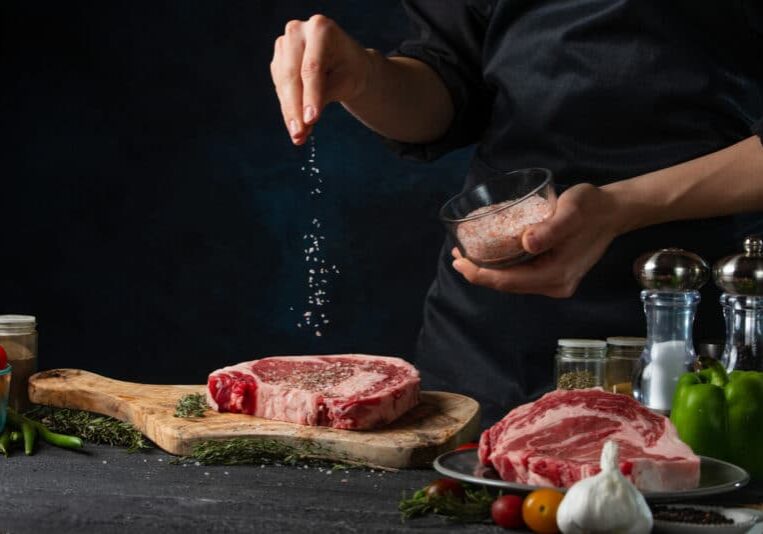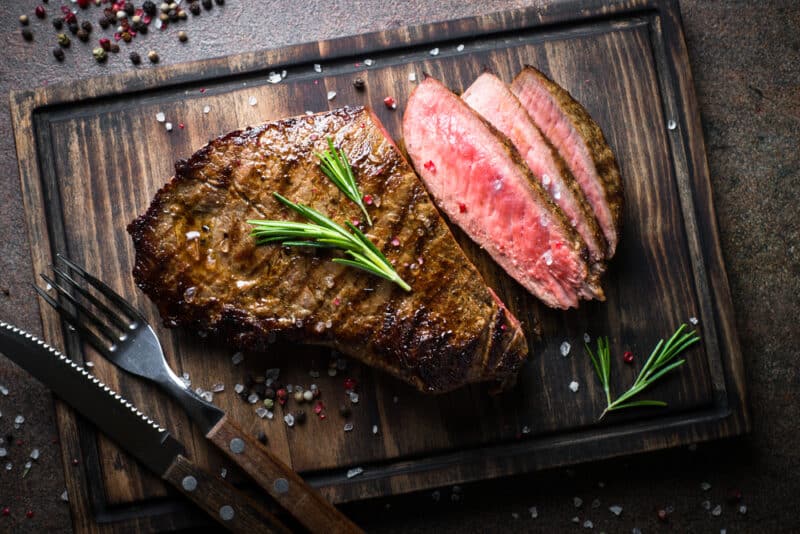Should You Leave the String on Your Prime Rib?
TheGrillingMaster.com is reader-supported. If you buy something using the links on our site, we might earn an affiliate commission at no added cost to you. This helps us pay our staff to keep making awesome content for you!

You should leave the string on your prime rib while it cooks, and remove the string when you are ready to slice the meat after it rests.
Prime rib is a highly sought-after cut of meat which is known for its mouthwatering flavor and tenderness. As a grilling and BBQ lover you’ve probably encountered the question of whether to leave the string on your prime rib or not.
This seemingly small detail can significantly impact the overall taste and presentation of your dish. In this article, I will explore the purpose of the string, weigh the pros and cons of keeping it on while cooking, and provide some expert tips for achieving the perfect prime rib every time. Let’s dive in and unravel the mystery of the prime rib string.
What is the purpose of the string on prime rib?
Prime rib, also known as standing rib roast, is a succulent and tender cut of beef that comes from the rib section of the animal.
It consists of a series of rib bones with the meat attached making it an impressive centerpiece for special occasions and family gatherings that generally everyone really loves.
The string plays a crucial role in the cooking process by holding the rib bones and meat together. This is very important because it ensures that the prime rib maintains its shape and cooks evenly.
How the string holds the rib bones and meat together
When the butcher prepares the prime rib, they often remove the rib bones and then tie them back onto the meat with a string. This process, called “trussing,” helps keep the meat and bones together during cooking.
The string acts as a supportive structure making sure that the meat stays firmly attached to the bones and maintains a compact shape. This is especially important when grilling or roasting prime rib because the heat can cause the meat to contract and potentially separate from the bones without the string.
Related Reading>> See how much prime rib do you need per person.
The benefits of trussing prime rib
Trussing prime rib with a string comes with several benefits that contribute to a better final product.
Firstly, it helps the meat retain its shape and giving it an appealing, uniform appearance when served.
A well-trussed prime rib will be more visually appealing than one that has been left untied because that could result in an uneven and unappetizing presentation.
Secondly, trussing promotes even cooking.
The string keeps the meat close to the bones which creates a distribution of heat throughout the prime rib. This is essential for achieving the desired level of doneness without overcooking or undercooking certain sections of the meat.

When to remove the string for different cooking methods
The decision to remove the string from your prime rib depends on your preferred cooking method and personal preferences.
If you’re roasting or grilling the prime rib whole it is best to leave the string on during the cooking process to maintain the shape and ensure even cooking. You should remove the string before carving and serving the meat.
On the other hand if you plan on cooking individual ribeye steaks it’s recommended to remove the string before cooking. This will allow you to season the meat more effectively and avoid the risk of overcooking the outer layers while trying to reach the desired internal temperature. I don’t’ really consider this method “cooking prime rib” and rather think of it has “cooking steaks”.
Pros of leaving the string on while cooking
Leaving the string on your prime rib during cooking offers several advantages that can enhance the overall quality and presentation of the dish. Here are the main benefits:
Maintains the shape of the prime rib
One of the primary reasons to keep the string on your prime rib is to maintain its shape throughout the cooking process.
The string holds the meat close to the bones keeping it compact and uniform. This both contributes to a more visually appealing final product but also helps the meat cook more evenly which will reduce the risk of uneven doneness.
Promotes even cooking
As mentioned earlier, trussing the prime rib with a string helps achieve even cooking. This is very important!
The string will keep the meat attached to the bones. The bones act as a natural heat conductor.
This will give you smooth distribution of heat throughout the prime rib and allows for consistent doneness from edge to edge.
You’re more likely to enjoy a juicy and perfectly cooked prime rib if you leave the string on while it cooks and rests.
Preserves moisture and tenderness
Another advantage of leaving the string on your prime rib is that it helps preserve moisture and tenderness.
By keeping the meat close to the bones the string allows the prime rib to baste in its own juices during cooking.
This self-basting process prevents the meat from drying out and will help to keep it tender, moist, and flavorful.
Enhances presentation
A well-trussed prime rib looks more impressive and visually appealing when presented at the table. Everyone will appreciate the presentation more with the string on.
The string holds the meat and bones together giving you neatly shaped roast that’s easy to carve and serve. This can elevate your dining experience and create a memorable impression for your guests.
Leaving the string on your prime rib during cooking can lead to a better-shaped roast and more even cooking with improved moisture and tenderness.
Related reading: See the ultimate guide for smoking tri tip here.
Cons of leaving the string on while cooking
Despite the advantages of keeping the string on your prime rib during cooking, there are also some potential drawbacks to consider. Here are the main cons:
Difficulty in removing the string after cooking
After cooking the prime rib with the string on removing the string can be a bit challenging if it has become embedded in the meat.
This may require extra care and attention to avoid tearing the meat or leaving behind small pieces of string.
Make sure to use a sharp knife or kitchen shears to carefully cut and remove the string before carving and serving… and please don’t accidentally cut yourself!
Potential for uneven seasoning
Leaving the string on the prime rib may create a barrier that prevents seasoning from fully penetrating the meat.
This can result in an unevenly seasoned roast with the outer layers receiving more flavor while the inner layers remain relatively bland.
To combat this issue, I season the meat generously before trussing so that the seasoning reaches all areas of the prime rib.
Possible overcooking of the outer layers
There’s a chance that the outer layers of the prime rib could cook more quickly than the inner layers because the string keeps the meat close to the bones.
This may lead to overcooked and dry outer portions while the center reaches the desired internal temperature.
To avoid this, you should monitor the internal temperature of the prime rib using a meat thermometer and adjust the cooking time and temperature accordingly.

More Reading>> How to keep prime rib warm for hours.
Tips for cooking with or without the string
Whether you decide to leave the string on your prime rib or remove it before cooking, following some expert tips can help you achieve the perfect roast.
Here are some useful suggestions I find work well:
Proper seasoning techniques
Seasoning your prime rib generously is essential for achieving a flavorful and delicious roast.
If you’re keeping the string on make sure the seasoning reaches all areas of the prime rib. If you’re removing the string then you should season the individual ribeye steaks evenly on all sides.
In both cases you should use a combination of salt, pepper, garlic, and herbs to bring out the natural flavors of the meat.
Adjusting cooking times and temperatures
To achieve the desired level of doneness is very simple, you just need to monitor the internal temperature of the prime rib using a meat thermometer. This will help you avoid overcooking or undercooking the meat.
A prime rib should be cooked at a lower temperature (around 225°F to 250°F) for a longer period to ensure even cooking, with a final sear at high heat to create a flavorful crust.
Be sure to calculate how many pounds of prime rib you need per person.
Alternative methods for trussing prime rib
If you choose to remove the string from your prime rib, you can explore alternative trussing methods, such as using silicone ties or heat-resistant bands. These alternatives can provide similar benefits to the string, such as maintaining the shape and promoting even cooking, while being easier to remove after cooking.
Related Reading>> How to reheat prime rib for max flavor.
Slicing and serving techniques
When it’s time to serve your prime rib, use a sharp carving knife to cut between the bones and create even slices.
If you’ve cooked the prime rib with the string on then you know to remember to remove it carefully before carving.
You can serve the prime rib with your choice of side dishes and sauces, such as horseradish sauce, au jus, or a red wine reduction.
Learn More About Grilling
If you want to learn more about grilling, check out these other helpful resources!

Patrick Harvey
Patrick is a life long grilling enthusiast with an eye for product development and user experience. His expertise helps us test and review all of the products you see the website.
About The Grilling Master
Hi there, I'm Kevin Turner, Founder and CEO of thegrillingmaster.com.
My passion has always been grilling, smoking and BBQ delicious meats that satisfy my inner carnivore!
I started this website to share my passion and knowledge with you, the hungry reader who wants to prepare the perfect meal.
You can leverage my years of experience as a pit master and professional.
Send me a message and let's connect on Twitter here.

















